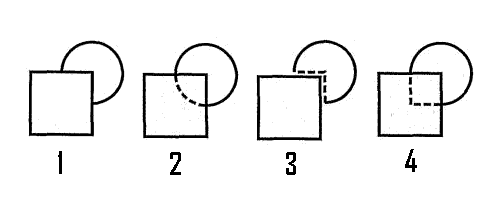Gestalt psychology was first introduced in 1912 by Max Wertheimer1), a German psychologist, when he published a paper on optical illusion called apparent motion. In the paper he analyzed the illusion occurring when a series of static images is perceived as movement, just like films. The assumption that whole is more than just sum of its parts is the basic principle of gestalt psychology.
Gestalt theory was introduced as a contrast to at the time dominant structuralism, which claimed that complex perceptions could be understood through breaking them into smaller elementary parts of experience, like splitting graphical forms into sets of dots or melody into sequence of sounds. Gestaltists attacked this theory: same melody can be recognized if transposed into another key and perception of a rectangle can be achieved through other forms than four lines. The idea of Wertheimer was that the ability to perceive objects was an ability of the nervous system, which tends to group together objects that are nearby, similar, form smooth lines, form most of the shape we can recognize. These are the four Wertheimer's laws of grouping:
Danish psychologist Edgar Rubin in 1921 introduced another important gestalt aspect of organization (although he wasn't a gestaltist himself), the figure-ground perception. Rubin suggested that a group of connected objects can mentally be interpreted as an object (figure) or surface behind it (ground) and formulated conditions describing when would which of that be the case.
The final Gestalt concept is the principle of Prägnanz, which claims that when visual stimulus can be interpreted in more ways (for example a partly hidden figure), people tend to organize it as simple, regular and symmetric as much as the conditions (information retrieved by the retina in the eye) allow. Gestaltists explained this through an idea of brains electric fields which reached an minimal energy state, but this theory is today mostly rejected.
 |  |  |
| 1. Similarity2) - similar objects are formed together to form the sun around eagles head | 2. Proximity3) - when close, nine rectangles are grouped as one object, when not, they are perceived as different objects | 3. Continuation4) - a smooth line is perceived as continuous |
 |  |  |
| 4. Closure5) - enough of the shape is present to mentally complete the image of a panda | Prägnanz6) - an ambiguous pattern (1) is recognized as as few simple shapes as possible (circle and rectangle over-leaping in 2) and not complex shapes (3,4) | Figure-ground perception: The Rubin goblet7) - if black region is recognized as foreground then two faces are recognized, if white region is recognized as foreground then a goblet is recognized, but the two can never be recognized simultaneously |
Gestaltist views on learning and problem-solving were opposed to at the time dominant pre-behaviorist and behaviorist views. Wertheimer emphasized importance of seeing the whole structure of the problem. Köhler performed experiments with animals learning through trial and error sessions. In his most famous example of insight learning in animals he gave a chimp named Sultan sticks that could be assembled together to form a longer one and placed a banana outside his cage out of his reach. Sultan, after considering the situation, suddenly jumped, assembled the sticks, and reached the banana. Discovery of correct solution to the problem was followed by insight occurrence. This presents insightful learning, which has following properties8):
Wertheimer suggested usage of gestalt principles in education. He contrasted productive thinking from rote learning, which occurs without understanding. Humans, unlike animals, can learn not only through conditioning or trial and error but also through explanations through changing their cognitive structure to achieve cognitive structure of the explainer, yet this should not be turned into rote learning. Problem-solving presents learning with understanding using gestalt principles. This learning is remembered for a long time, and can be applied to other situations. Gestaltism therefore suggests that learners should be encouraged to discover whole nature or relationships between elements of a problem, but also to exclude implicit assumptions that might be incorrect. Since human mind functions in accordance with the mentioned principles, instructional design should be based on proximity, closure, similarity and simplicity.
Application of gestalt laws has been suggested for concept and knowledge maps design (considering colors, shapes and groupings), where it has provided positive results9).
Gestalt theory was mostly criticized for:
Gestalt theory has inspired psychologist like Kurt Lewin or Kurt Goldstein, who introduced it in other aspects of psychology. Gestalt views also inspired later cognitivist theories.
Rock, I. and Palmer, S. The Legacy of Gestalt Psychology. Scientific American, 263(6), p48-61. 1990.
TIP: Theories. Gestalt Theory (Wertheimer). Retrieved March 21, 2011.
Boeree, G. General Psychology - Perception and Interaction. Retrieved March 21, 2011.
Koffka, Kurt. Principles of Gestalt Psychology. Routledge, 1999.
Wertheimer, M. A source book of Gestalt psychology. Hartcourt, Brace and Co, New York, 1938.